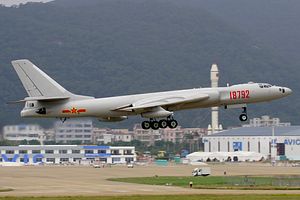The People’s Liberation Army Air Force (PLAAF) flew six Xian H-6K long-range bombers through the strategically important Miyako Strait on July 13, Japan’s Ministry of Defense (MoD) revealed in a press release this week.
The Miyako Strait is located between the Japanese islands of Miyako and Okinawa. Consisting of a small passageway with international waters and airspace, the strait is one of the principal gateways for the People’s Liberation Army Navy (PLAN) to the Pacific Ocean.
In response to the PLAAF patrol, the Japan Air Self-Defense Force (JASDF) dispatched an unknown number of fighter jets. According to the Japanese MoD, the Chinese bombers did not violate Japanese airspace.
The Chinese Ministry of Defense said in a statement that it was “legal and proper” for the PLAAF to operate in the airspace and that it was a routine exercise and “no cause for alarm or speculation.”
Furthermore, the ministry said in statement that Japan “should not make a fuss about nothing or over-interpret, it will be fine once they get used to it.” In March 2013, Japan scrambled fighter jets in response to a Chinese military exercise involving 13 aircraft flying through the Miyako Strait.
The PLAAF carried out similar drills in the Miyako Strait in September, November, and December respectively. In all three instances the JASDF dispatched fighter jets. According to the Japanese MOD, the JASDF scrambled its fighter jets 1,168 times in fiscal year 2016, up from 873 in 2015.
As I reported in February, the JASDF has doubled the number of fighter jets dispatched to intercept foreign military aircraft approaching Japanese airspace from two to four in 2016. The JASDF stood up a new air wing consisting of Mitsubishi F-15J all-weather air superiority fighters in Okinawa in 2016, which doubled the number of fighter jets there from 20 to 40.
“The doubling of aircraft used for scrambles against foreign military aircraft will put additional pressure on an already overstretched JASDF,” I explained elsewhere. “Unless Japan steps up its procurement process and accelerates the introduction of new aircraft (e.g. the F-35), the JASDF will likely face a shortage of fighter aircraft in the 2020s.”
The H-6K long-range bomber is a derivative of the Soviet-era Tupolov Tu-16 twin-engined jet strategic bomber. In 2007, the PLAAF introduced the bomber’s latest variant fitted with a more powerful and fuel-efficient engines and modern electronics.
The bomber can carry a payload of up to 12 tons. “The H-6K, which lacks stealth capacity, can carry up to seven YJ-12 supersonic anti-ship missiles (six on wing pylons plus one in the bomb bay) or CJ-20 subsonic land-attack cruise missiles with an estimated range of 250 and 1,500 miles respectively,” I wrote in October 2015.

































